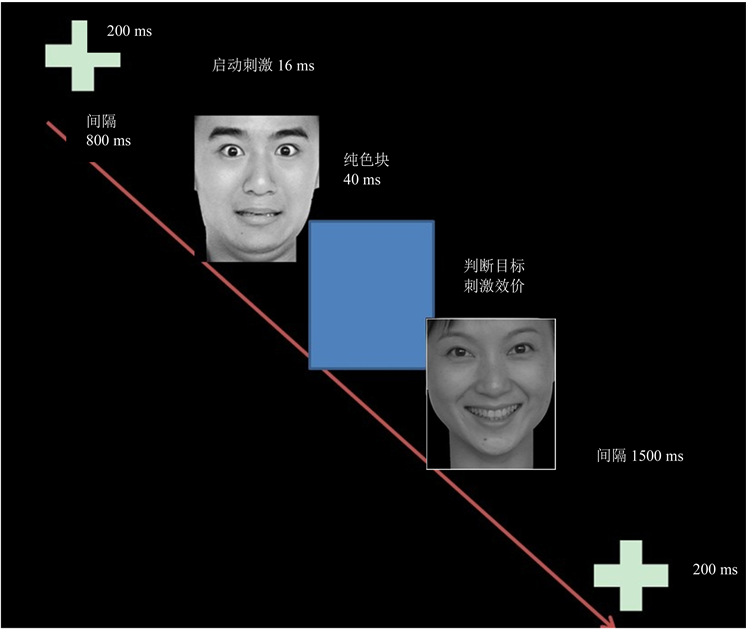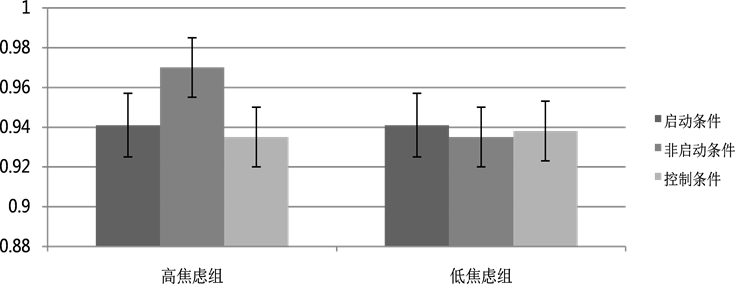1. 引言
认知行为理论认为,对负性信息的注意偏向是焦虑障碍的核心特征,也是导致焦虑持续和发展的重要因素(Schultz & Heimberg, 2008)。当与威胁信息相关的注意加工过程引起我们强烈的知觉和反应时,其可能与不适应的加工模式相关联,从而导致高特质焦虑甚至是焦虑障碍(Sheppes, Luria, Fukuda, & Gross, 2013)。对焦虑个体注意偏向的研究,集中在负性信息上的比较多(Schultz & Heimberg, 2008;吕创,牛青云,张学民,2014)。有研究发现了高焦虑者对负性面孔的注意偏向(Mcgrath et al., 2016),以及高特质焦虑个体对生气面孔的注意偏向(Dodd, Vogt, Turkileri, & Notebaert, 2016)。Weeks等人(2008)的研究发现,社交焦虑个体即使在没有威胁的社交情境中,也体验着焦虑情绪,体现在害怕吸引他人的注意,以及将他人给自己的积极评价视作未来要作出的社交补偿而感到恐惧。虽然近几年对正性信息的研究日趋增多。但多数都关注社交焦虑个体,对特质焦虑个体的积极情绪及体验的过程关注很少。认识到焦虑个体对情绪面孔加工的特点,可以帮助我们更好地训练焦虑个体对刺激的关注和解释,也可以更好地利用加工特性为焦虑障碍的个体提供相应的咨询和治疗。
情绪启动范式是研究焦虑个体认知偏向比较常用的工具。分为阈上和阈下启动,在阈下情绪启动实验中,启动刺激呈现的时间十分短暂,以至于被试无法意识到启动刺激的存在,但启动刺激的性质依然影响被试对目标刺激性质的判断。焦虑对威胁的偏向是有意识的还是无意识的还不明确。使用阈下呈现刺激能说明焦虑个体早期、自动的结构对威胁更敏感,而不是晚期的有意识加工。
以往关于情绪启动的研究发现了情绪一致性效应,即把中性目标性质判断为与启动刺激一致的倾向(Sweeny, Grabowecky, Suzuki, & Paller, 2009;叶彬等,2016)。也有研究发现情绪启动的相容性效应。即个体对与启动图片效价一致的图片反应更快,判断正确率更高。姚泥沙等人(2013)发现了控制组被试的相容性效应,而高社交焦虑个体表现出不相容:他们在正性–正性条件下的反应时显著慢于控制组被试,解释为他们不能充分理解正性社交材料中的积极含义。而Weeks等人(2008)认为,社交焦虑个体害怕正性的评价,焦虑个体对正性启动图片的启动表现出了不相容性,而控制组表现出相容,即,焦虑个体对正–正图片的反应时更慢,控制组更快。可见,被试不仅受启动刺激效价的影响,也会受目标刺激效价的影响。
综上所述,焦虑个体对负性信息存在注意偏向,但焦虑个体对正性信息是否也存在注意偏向,以及这种偏向是否是无意识,目前还不清楚。本研究拟采用中国化面孔情绪图片系统(黄宇霞,罗跃嘉,2004)作为刺激材料,启动图片通过阈下方式呈现,采用2 (高焦虑组,低焦虑组) × 2 (目标图片正性,目标图片负性) × 3 (启动条件,非启动条件,控制条件)的实验设计。分别比较高、低特质焦虑个体在不同情绪启动条件下对目标图片进行正、负性判断的正确率的差异。本研究假设:高特质焦虑个体会对情绪面孔产生无意识注意偏向,影响被试对目标图片的判断。
2. 对象与方法
2.1. 被试
通过在北京4所高校张贴广告及在网上发放电子版问卷的方式,共发放800份问卷,施测问卷为《状态-特质焦虑问卷》之特质焦虑问卷(STAI-T)。选出高于75%分位数和低于25%分位数各80名大学生作为候选被试。综合被试意向,排除身体疾病等因素,最终确定被试60人(26男,34女)。被试分两组。高焦虑组(27人:6男,21女,平均年龄22.7岁,标准差2.15),平均特质焦虑48.5,标准差6.02,低焦虑组(33人:20男,13女,平均年龄22.9岁,标准差1.67),平均特质焦虑32.2,标准差2.91。
2.2. 实验材料
从中国化面孔情绪图片系统(黄宇霞,罗跃嘉,2004)中选出恐惧、喜悦和中性三种表情的图片,每种表情30张,一共有90种不同面孔刺激。恐惧图片的愉悦度平均值为2.60 (从1.89~3.09),标准差为0.34;喜悦图片的愉悦度平均值为6.80 (从6.27~7.77),标准差为0.38;中性图片的愉悦度平均值为4.90 (从4.45~5.45),标准差为0.29。恐惧图片的唤醒度的平均值是6.85,标准差为0.92;快乐图片的唤醒度的平均值是6.21,标准差为0.80;中性图片的唤醒度的平均值是3.68,标准差为0.42。将三种情绪图片进行随机配对,形成六种配对类型(正–正、负–负、正–负、负–正、中–正、中–负)。三种启动条件:启动条件、非启动条件和控制条件。如表1所示。确保同一张图片不会出现于相临的两个任务中,并且任意配对中的启动图片和目标图片都不相同。
2.3. 实验程序
通过Presentation软件在15寸CRT电脑屏幕呈现所有的刺激材料,刷新频率设置为120 Hz。图片位于屏幕中央,被试者坐在屏蔽室中一张舒适的椅子上,双眼注视屏幕中央,眼睛距屏幕约0.8米。要求被试者双手握住无线鼠标,又快又准的判断目标图片的正负。若为正性图片,则用左手拇指按下左键,

Table 1. Three types of priming conditions
表1. 三种情绪启动条件的组合类型
若为负性图片,则用右手拇指按下右键。在被试间平衡两个按键。
2.3.1. 阈下情绪启动任务
每个情绪启动任务中,先在屏幕中央呈现一个200 ms的固定点+,在间隔800 ms黑屏后,迅速呈现16 ms的启动图片,随后用40 ms纯色块图片将其完全掩蔽,然后目标图片随机出现,被试者对目标图片进行按键反应,反应后间隔1500 ms进行下一个任务。如图1。实验分2个组,每组120个任务,共240个任务。所有任务以及配对类型的顺序都是随机呈现的。在被试间平衡序列施测顺序。实验开始之前,先让被试完成4个练习试次,以便熟悉并掌握按键和实验流程。
2.3.2. 意识检测阶段
为检验被试是否意识到阈下呈现的图片,在被试判断图片的效价之后,进行五步顺序的简短谈话。以下问题逐一对被试进行询问,若回答否,就终止问题。
1) 除了十字和需要判断情绪正负的面孔之外,你看见什么别的了么?
2) 在十字和面孔之间,你看见什么别的了么?
3) 在十字和面孔之间确实有个闪影,你看见什么了?

Figure 1. Subliminal emotional priming
图1. 阈下情绪启动任务
4) 你看见一张脸或是什么颜色了么?
5) 你看见脸上是什么表情了么?
2.4. 统计方法
采用SPSS17.0软件。采用2 × 2 × 3重复测量方差分析,组间因素为组别(高焦虑组、低焦虑组),组内因素分别为目标图片效价(正性、负性)和情绪启动条件(启动条件、非启动条件、控制条件),因变量为目标图片效价判断的正确率。
3. 结果
3.1. 意识检测结果
结果显示:34人报告在十字和需要判断的面孔之外以及之间,没有看见任何东西。8人报告在十字和目标表情之间看到了闪影,但不知道闪影是什么。14人报告在目标表情之前看到了一张脸,但看不清是什么表情。4人报告在目标表情之前看到了一张脸,有时能看出脸上的表情和目标表情一致,有时看到和目标表情相反,有时看不清表情。无人报告看到了色块。基于以上主观报告,有理由推断被试没有意识到启动面孔的情绪内容,即启动刺激的情绪内容在被试的主观阈限之下。
3.2. 数据统计结果
三种条件下的正确率见表2。
对数据进行2 (高焦虑组,低焦虑组) × 2 (正性,负性) × 3 (启动条件,非启动条件,控制条件)重复测量方差分析,因变量为对目标图片效价判断的正确率。结果显示,1) 目标图片效价的主效应显著,F(1, 58) = 6.95,P < 0.05,η2 = 0.11。2) 目标图片效价与启动条件的交互作用显著,F(2, 57) = 6.86,P < 0.05,η2 = 0.19。3) 目标图片效价与启动条件与组别的交互作用显著,F(2, 57) = 3.98,P < 0.05,η2 = 0.12。4) 其他效应均不显著。
3.2.1. 目标图片为正性时,高低焦虑组在不同启动条件下对图片的判断的正确率
目标图片为正性时,对数据进行3 (启动条件,非启动条件,控制条件) × 2 (高焦虑组,低焦虑组)重复测量方差分析,因变量为对目标图片效价判断的正确率。结果显示1) 启动条件的主效应不显著,F(2, 57) = 2.64,P > 0.05,η2 = 0.09。2) 启动条件与焦虑组别交互作用显著,F(2, 57) = 4.65,P < 0.05,η2 = 0.14。简单效应分析表明,高焦虑组在非启动条件下对正性图片判断的正确率显著高于启动条件和控制条件,低焦虑组在三种条件下对正性图片判断的正确率没有显著差异。如图2。
3.2.2. 目标图片为负性时,高低焦虑组在不同启动条件下对图片的判断的正确率
目标图片为负性时,对数据进行3 (启动条件,非启动条件,控制条件) × 2(高焦虑组,低焦虑组)重复测量方差分析,因变量为对目标图片效价判断的正确率。结果显示1)启动条件的主效应显著,两组被试在启动条件与控制条件下,对负性图片判断的正确率显著高于非启动条件,F(2, 57) = 4.32,P < 0.05,

Table 2. The correct rates of judgments of target pictures in subliminal emotional priming (M ± SD)
表2. 阈下启动对目标图片判断的正确率(M ± SD)

Figure 2. The interaction effect between the subliminal priming conditions and the anxiety groups
图2. 阈下启动条件与焦虑组别的交互作用
η2 = 0.13,如图3。2) 启动条件与焦虑组别交互作用不显著,F(2, 57) = 1.77,P > 0.05,η2 = 0.06。
3.2.3. 阈下启动条件下,高低焦虑组对正负目标图片判断的正确率
在启动条件下,对数据进行2 (高焦虑组,低焦虑组) × 2 (目标图片正性,目标图片负性)重复测量方差分析,因变量为对目标图片效价判断的正确率。结果显示1) 目标图片效价的主效应显著,F(1, 58) = 9.52,P < 0.05,η2 = 0.14。2) 目标图片效价与焦虑组别交互作用显著,F(1, 58) = 4.80,P < 0.05,η2 = 0.08。简单效应分析表明,高焦虑组对负性目标图片判断的正确率显著高于正性图片,低焦虑组对两种效价图片判断的正确率差异不显著。
3.2.4. 阈下非启动条件下,高低焦虑组对正负目标图片判断的正确率
在非启动条件下,对数据进行2 (高焦虑组,低焦虑组) × 2 (目标图片正性,目标图片负性)重复测量方差分析,因变量为对目标图片效价判断的正确率。结果显示1) 目标图片效价的主效应不显著,F(1, 58) = 0.16,P > 0.05,η2 = 0.003。2) 目标图片效价与焦虑组别的交互作用不显著,F(1, 58) = 0.50,P > 0.05,η2 = 0.009。
3.2.5. 阈下控制条件下,高低焦虑组对正负目标图片判断的正确率
在控制条件下,对数据进行2 (高焦虑组,低焦虑组) × 2 (目标图片正性,目标图片负性)重复测量方差分析,因变量为对目标图片效价判断的正确率。结果显示1) 目标图片效价的主效应显著,两组被试对负性目标图片判断的正确率显著高于正性目标图片,F(1, 58) = 13.88,P < 0.05,η2 = 0.19。2) 目标图片效价与焦虑组别的交互作用不显著,F(1, 58) = 3.27,P > 0.05,η2 = 0.05。
4. 讨论
本研究使用情绪启动范式,研究了不同特质焦虑个体,在不同启动条件下对情绪面孔效价判断的差异。
4.1. 目标图片效价为正/负时,高低焦虑组在不同启动条件下对图片的判断
当呈现正性目标图片时,高焦虑个体对负–正匹配的图片判断的正确率高,与相容性效应相左。这表明,高特质焦虑个体对负面信息产生了无意识的注意偏向,而低焦虑个体没有。尽管启动刺激在阈下
图3. 阈下启动条件的主效应
呈现,又用色块对其进行掩蔽,但威胁刺激仍然能够通过皮层下–丘脑–杏仁核通路进行加工(Vizueta, Patrick, Yi, Thomas, & Sheng, 2011)。可以推测,阈下恐惧情绪启动下,高TA个体比低TA个体产生了更多的杏仁核激活,从而触发了其更高的正确率。有研究发现,在恐惧情绪唤醒条件下,被试对积极词汇命名的反应时快于中性词(袁承杰,于凯,刘伟志,尚志蕾,2015)。这也与前人研究一致:高特质焦虑个体对威胁信息的无意识加工会增强对信息的意识加工(崔丽霞,杨洁莹,史光远,张钦,方平,2013),且这个过程是在认知加工的早期阶段(Carlson, Cha, & Mujicaparodi, 2013)。
当呈现负性目标图片时,高低焦虑个体在启动和控制条件下的正确率显著高于非启动条件。以往研究也有类似的结果(蚁金瑶,钟明天,凌宇,罗英姿,姚树桥,2007)。本研究所使用的负性图片是恐惧面孔。这和前人的研究一致:恐惧情绪由于具有特殊意义而更容易被登记,人们对恐惧情绪的反应强于其它表情(Batty & Taylor, 2003),从而影响到对任务的判断。而在非启动条件下,启动图片和目标图片不一致,出现了不相容,抑制了被试对目标图片的判断。
4.2. 不同阈下启动条件下,高低焦虑组对正负目标图片的判断
在启动条件下,高焦虑个体出现了负性情绪启动,表现为对负性图片判断的正确率显著高于正性图片;但低焦虑个体没有显著差异。结果表明,高焦虑个体对于威胁信息(负性图片)产生了无意识注意偏向,而低焦虑个体没有。与以往研究一致,焦虑个体比低焦虑个体更容易将注意朝向威胁信息,即偏向(Barhaim et al., 2007; Mogg et al., 1997)。
在控制条件下,高、低焦虑个体都表现出了对目标图片效价的主效应,表现为高焦虑组个体和低焦虑组个体对负性目标图片判断的正确率显著高于正性目标图片。在控制条件下,启动图片是中性面孔,被试主要受目标图片的影响。可能是因为恐惧表情更容易引起人的警觉,因此正确率更高。
本研究没有发现焦虑个体和积极情绪的关系。但从原理上来说,积极和消极情绪有着完全不同的体验、认知和行为过程。Paul等人(2012)发现了正性图片的启动效应。杨鹏等人(2015)发现了焦虑个体对正性刺激存在认知偏差。焦虑个体在不同启动条件下对于正性刺激材料的反应的研究结果迥异,本研究的结果为这个仍在讨论中的问题提供了依据。焦虑个体和正性刺激的关系目前还不明确,未来的研究可以作进一步探讨。
本研究也存在以下局限。首先,高焦虑组被试的性别偏态化,因此高低焦虑组的差异是否由男女比例的差异引起的不得而知。第二,只采用了正确率的行为指标,可能不够敏感。
5. 结论
本研究发现:高特质焦虑个体对于威胁信息产生了无意识注意偏向,且增强了信息的有意识加工。人们对恐惧情绪的反应强于其它表情。
基金项目
国家自然科学基金面上项目(31571143)。
NOTES
*通讯作者。